211 - 225 of 319 records
World must be made safe for Democracy!
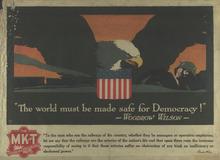
Description:
Poster showing eagle above stars and stripes emblem with enemy soldier wearing a horned helmet, and a train in the background.
Member of:
Resource Type:
Still Image
All in the day's work
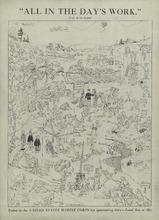
Description:
U.S. Marines recruitment poster showing recruits engaged in various activities at a Marine Corps training camp.
Member of:
Resource Type:
Still Image
Shall we be more tender with our dollars than with the lives of our sons
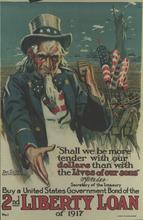
Description:
Uncle Sam with armies in background; Statue of Liberty also in background with planes in the air and ships in the sea.
Member of:
Resource Type:
Still Image
Follow the flag
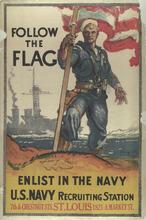
Description:
Poster showing sailor planting flag on hill with ship in background.,Remainder of text reads: U.S. Navy Recruiting Station, 7th & Chestnut Sts., St. Louis, 1821-A Market St.,Composition H. R.,MU: Poster somewhat damaged.
Member of:
Resource Type:
Still Image
U. S. Marine recruits learn field cooking
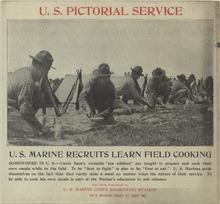
Description:
Poster showing soldiers cooking in a field.,Text continues: Somewhere in U. S.--Uncle Sam's versatile sea soldiers are taught to prepare and cook their own meals while in the field. To be first to fight is also to be first to eat. U. S. Marines pride themselves on the fact that they rarely miss a meal no matter what the nature of their service. To be able to cook his own meals is part of the Marine's education in self reliance.,This photo furnished by U. S. Marine Corps Recruiting Station, 122 North Seventh Street, St. Louis, Mo.,MU: Poster mounted on canvas.
Member of:
Resource Type:
Still Image
Help deliver the goods
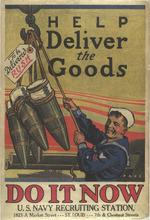
Description:
MU: Under title: U. S. Navy Recruiting Station, 1821-Market Street --- St. Louis --- 7th & Chestnut Streets (010-508818950) #117 written in red in lower right corner (010-508880267).,MU: Poster mounted on canvas.,Poster showing sailor pulling cable over hook, large ammunition shells attached to cable.
Member of:
Resource Type:
Still Image
Giant artillery tractor used by U.S. Marines
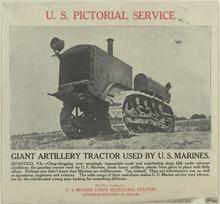
Description:
Poster showing photograph of giant artillery tractor.,Text continues: Quantico, VA.--Chug-chugging over seemingly impassable roads and negotiating steep hills under adverse conditions, the gasoline tractor used by U. S. Marines, hauls heavy artillery pieces from place to place with little effort. Perhaps you didn't know that Marines are artillerymen. Yes, indeed! They are infantrymen, too, as well as signalmen, engineers and aviators. The wide range of their usefulness makes U. S. Marine service very attractive for the red-blooded young man looking for something different.,This photo furnished by U. S. Marine Corps Recruiting Station, 122 North Seventh Street, St. Louis, MO.
Member of:
Resource Type:
Still Image
JM-161: The refining influence of speculating in war stock
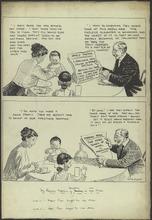
Description:
This cartoon shows two impressions of the same family living in the United States during World War I. The top panel displays the family before they bought war stocks. The bottom panel shows them after they purchased war stocks. In the top panel, the mother and father are lamenting on the carnage of the war, causing the death of millions in Europe. The couple is horrified at the seemingly senseless loss of life. In the bottom panel, the couple are thrilled the war is expected to drag on, because the value of their war stocks will continue to increase and provide a temporarily sustained income to the family. This cartoon is meant to illustrate Americans' disturbing lack of empathy at the mere promise of profit. The United States notoriously made large profits throughout most of World War I selling weapons to use in the war, while remaining neutral in the conflict until 1917. (Summary created by Mary Delano, MU History Intern, Spring 2018)
Member of:
McCutcheon Editorial Cartoons - ALL (Collection)
Resource Type:
Still Image
JM-180: In the national army parade today, you are likely to see the man you'll all be cheering and voting for in years to come
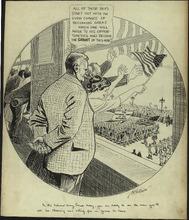
Description:
This editorial cartoon depicts people watching the National Army of the Republic parade outside the window. A man wonders who will be "the Grant of this war." This is most likely one of the many parades held by military forces while the United States was fighting in WWI. This cartoon is captioned. "In the National Army Parade today, you are likely to see the man you'll all be cheering and voting for in years to come". The "Grant of this war" is a clear reference to Ulysses Grant, the eighteenth president of the United States from 1869 to 1977. Ulysses Grant was a general in the Civil War, and he is often given much credit for the Union's victory. After being appointed General-in-Chief by Abraham Lincoln in 1864, Grant would accept General Lee's surrender at Appomattox Court House, which effectively ended the Civil War. This cartoon suggests the future leaders of the United States would likely have served in World War I. (Summary created by Mary Delano, MU History Intern, Spring 2018)
Member of:
McCutcheon Editorial Cartoons - ALL (Collection)
Resource Type:
Still Image
JM-137: 1912 Presidential Election

Description:
This cartoon illustrates the events that occured in the presidential election of 1912. The top left panel shows former president, Theodore Roosevelt, obviously beating Taft in the primary elections. This reflected the fact that most voters at the time preferred Theodore Roosevelt to President Taft for reelection. The top right panel shows President Taft winning the primary election, because Roosevelt has been tackled by the credentials committee. The credentials committee was responsible for determining, which men were eligible to vote in the primary elections of 1912. The middle panel shows nominations for the Republican primary. The nomination of the left is for former President Theodore Roosevelt. The nomination on the right is for Charles Evans Hughes, former governor of New York. The bottom panel shows the race continuing, and a group of men sitting in a room. (Summary created by Mary Delano, MU History Intern, Spring 2018)
Member of:
McCutcheon Editorial Cartoons - ALL (Collection)
Resource Type:
Still Image
JM-128: Shake hands with my friend, Canadian Reciprocity
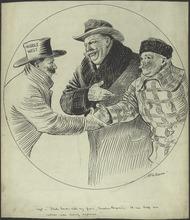
Description:
Editorial cartoon depicting William Howard Taft encouraging a free trade accord between the Midwest and Canada.
Member of:
McCutcheon Editorial Cartoons - ALL (Collection)
Resource Type:
Still Image
JM-145: The Senate passes a parcels post bill
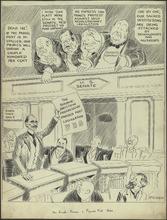
Description:
This cartoon shows the US Senate passing the Post Office Appropriation Bill of 1912. The most controversial part of this legislation was the parcels post provision being held up in the comic. This provision divided the country into zones, which would be used to determine postage prices in the US. The provision was introduced by Senator Jonathan Bourne of Oregon to create uniform postage prices within specific areas of the United States. Senator Joseph Bristow of Kansas originally objected to the provision, claiming the price proposals of postage were too low to sustain. Eventually, the senators reached a compromise and the bill was passed with the maximum postage rate of 12 cents per first pound shipped within the total of eight zones created. This bill was thought to be beneficial to small businesses, regularized and lowering costs in specific zones. This bill was not well received by many within the US, particularly with some big business, as represented by the four large men in the top of the cartoon. One of these men reference former Senator Thomas Platt, an infamous political boss for the Republican party. The comment shows a shift occurring within Congress from conservative to more progressive policies during the 1910s. This shift is seen by the man commenting, "Darn those daily moosepapers". This comment is most likely a reference to the progressive policies of President Theodore Roosevelt, who founded the Bull-Moose party in 1912. (Summary created by Mary Delano, MU History Intern, Spring 2018)
Member of:
McCutcheon Editorial Cartoons - ALL (Collection)
Resource Type:
Still Image
JM-162: Why the U. S. must be strictly neutral
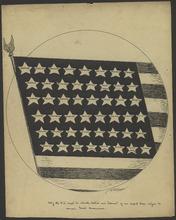
Description:
This comic depicts the United States flag having forty eight stars, because Hawaii and Alaska would not become states until 1959. Each star has a ethnicity or nationality listed on it to represent the different types of immigrants assimilating and/or remaining in the United States after moving from different locations. The quote below the comment reads, "Why the US must be strictly neutral and tolerant if we expect these citizens to remain good Americans." This cartoon suggests that if the United States were to enter World War I, it would outrage the immigrants of the countries upon which the United States declared war. This was a common concern of United States citizens before the United States entered World War I. (Summary created by Mary Delano, MU History Intern, Spring 2018)
Member of:
McCutcheon Editorial Cartoons - ALL (Collection)
Resource Type:
Still Image
JM-160: The Christmas Carol that was not rehearsed
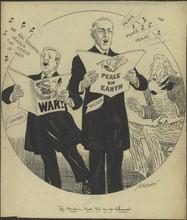
Description:
This cartoon highlights and humorizes the lack of agreement between President Woodrow Wilson and his Secretary of State, Robert Lansing. In December of 1916, President Wilson issued a peace note, explaining his position on the United States involvement in World War I. President Wilson wished to help negotiate peace talks between the allies and Germany, which had been recently suggested by Germany. President Wilson also wished to keep the United State a neutral party within World War I, not providing military support to either side. In this peace note, Lansing offered an addendum saying, "The United States already in the war economically, was being drawn in militaristically." This caused a great upset in the Wilson administration as the President tried to emphasize the need for peace without completely discrediting his Secretary of State. The cartoon highlights this discomfort by showing Lansing and President Wilson essentially singing a different tune. A shocked Uncle Sam (citizens of the United States) sits listening to the pair and is unsure what to think of the spectacle. This cartoon uses Christmas carols as a humorous reminder that this incident occurred within the week before Christmas in December of 1916, less than six months before the United States would eventually enter World War I. (Summary created by Mary Delano, MU History Intern, Spring 2018)
Member of:
McCutcheon Editorial Cartoons - ALL (Collection)
Resource Type:
Still Image
JM-164: Will there be enough to go round?
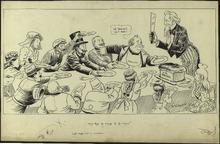
Description:
This cartoon depicts Uncle Sam trying to divide "U.S. Bread" among various nations. In 1915, World War I was being fought in Europe, but the United States was maintaining a neutral position. Despite its neutrality, the United States supplied resources and arms to nations during the war. All of the countries sitting at the table are nations who lobbied for resources from the United States during the war. England is attempting to block Germany's chance of receiving resources from Uncle Sam. This is representative the attempts of the British government to limit the United States aid to Allied Powers, most often England. The United States is also sitting at the table, looking worried about sharing the beard with other nations. The United States distributing more resources than it could afford was a fear for many Americans in the 1910s. (Summary created by Mary Delano, MU History Intern, Spring 2018)
Member of:
McCutcheon Editorial Cartoons - ALL (Collection)
Resource Type:
Still Image
Pagination
- Previous page
- Page 15
- Next page